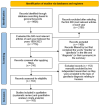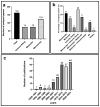Systematic Review of Diagnostic Approaches for Human Giardiasis: Unveiling Optimal Strategies
- PMID: 38396402
- PMCID: PMC10887752
- DOI: 10.3390/diagnostics14040364
Systematic Review of Diagnostic Approaches for Human Giardiasis: Unveiling Optimal Strategies
Abstract
Giardiasis, caused by the protozoan Giardia intestinalis, affects around 400 million people worldwide, emphasizing the critical need for accurate diagnosis to enhance human health, especially in children. Prolonged giardiasis in childhood can lead to intellectual deficits and other complications. A variety of diagnostic tools, including microscopic, immunological, and molecular methods, are available for detecting G. intestinalis infection. Choosing the most suitable method can be challenging due to the abundance of options. This systematic review assesses the reliability and applicability of these diagnostic modalities. Utilizing the Dimensions and Wordart platforms for data analysis, we focus on relevant literature addressing diagnostic methods for human giardiasis. Microscopic techniques, particularly Ritchie's method, emerge as the primary choice, followed by enzyme-linked immunosorbent assay (ELISA) and polymerase chain reaction (PCR). PCR's limited use is attributed to its high cost and infrastructure challenges in developing nations. In conclusion, our analysis supports microscopic methods as the gold standard for giardiasis diagnosis. However, in cases where symptoms persist despite a negative diagnosis, employing more sensitive diagnostic approaches is advisable.
Keywords: ELISA; Giardia; PCR; diagnostic; microscopy; systematic review.
Conflict of interest statement
The authors declare no conflicts of interest.
Figures







Similar articles
-
Giardia intestinalis in patients with nonulcer dyspepsia.Arab J Gastroenterol. 2013 Sep;14(3):126-9. doi: 10.1016/j.ajg.2013.08.004. Epub 2013 Sep 19. Arab J Gastroenterol. 2013. PMID: 24206742
-
IMMUNE-MOLECULAR IDENTIFICATION OF GIARDIA INTESTINALIS IN DIARRHOEAL CHILDREN: COMPARISON OF THREE DIAGNOSTIC METHODS.J Egypt Soc Parasitol. 2016 Aug;46(2):253-260. J Egypt Soc Parasitol. 2016. PMID: 30152936
-
[The results of the diagnosis of giardiasis in children with the use of the method of microscopy, enzyme immunoassay, polymerase chain reaction.].Klin Lab Diagn. 2019;64(6):376-379. doi: 10.18821/0869-2084-2019-64-6-376-379. Klin Lab Diagn. 2019. PMID: 31200411 Russian.
-
Giardiasis: An Overview.Recent Pat Inflamm Allergy Drug Discov. 2019;13(2):134-143. doi: 10.2174/1872213X13666190618124901. Recent Pat Inflamm Allergy Drug Discov. 2019. PMID: 31210116 Review.
-
Immunological methods of diagnosis in giardiasis: an overview.Ann Clin Lab Sci. 1991 Mar-Apr;21(2):116-22. Ann Clin Lab Sci. 1991. PMID: 2029174 Review.
Cited by
-
Red Fox (Vulpes vulpes) and Wolf (Canis lupus) as a Reservoir of Cryptosporidium spp. and Giardia intestinalis in Poland.Pathogens. 2025 May 20;14(5):500. doi: 10.3390/pathogens14050500. Pathogens. 2025. PMID: 40430819 Free PMC article.
-
Trichomoniasis and Other Sexually Transmitted Parasitic Diseases in Women.Clin Obstet Gynecol. 2025 Jun 1;68(2):194-205. doi: 10.1097/GRF.0000000000000945. Epub 2025 Apr 14. Clin Obstet Gynecol. 2025. PMID: 40226933 Free PMC article. Review.
-
Tunneling Nanotube-like Structures in Giardia duodenalis.Cells. 2024 Sep 13;13(18):1538. doi: 10.3390/cells13181538. Cells. 2024. PMID: 39329722 Free PMC article.
-
Human Giardiasis in Ghana - A Scoping Review of Studies From 2004 to 2024.Health Sci Rep. 2025 May 5;8(5):e70822. doi: 10.1002/hsr2.70822. eCollection 2025 May. Health Sci Rep. 2025. PMID: 40330749 Free PMC article.
References
-
- Kirk M.D., Pires S.M., Black R.E., Caipo M., Crump J.A., Devleesschauwer B., Döpfer D., Fazil A., Fischer-Walker C.L., Hald T., et al. World Health Organization Estimates of the Global and Regional Disease Burden of 22 Foodborne Bacterial, Protozoal, and Viral Diseases, 2010: A Data Synthesis. PLoS Med. 2015;12:1001921. doi: 10.1371/journal.pmed.1001921. - DOI - PMC - PubMed
Publication types
LinkOut - more resources
Full Text Sources

